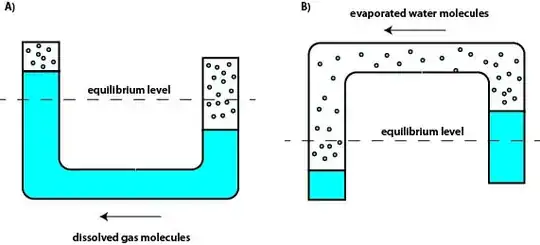Summary: I find a formula for the diameter of a bubble large enough to support one human and plug in known values to get $d=400\,{\rm m}$.
I'll have a quantitative stab at the answer to the question of how large an air bubble has to be for the carbon dioxide concentration to be in a breathable steady state, whilst a human is continuously producing carbon dioxide inside the bubble.
Fick's law of diffusion is that the flux of a quantity through a surface (amount per unit time per unit area) is proportional to the concentration gradient at that surface,
$$\vec{J} = - D \nabla \phi,$$
where $\phi$ is concentration and $D$ is the diffusivity of the species. We want to find the net flux out of the bubble at the surface, or $\vec{J} = -D_{\text{surface}} \nabla \phi$.
$D_{\text{surface}}$ is going to be some funny combination of the diffusivity of $CO_2$ in air and in water, but since the coefficient in water is so much lower, really diffusion is going to be dominated by this coefficient: it can't diffuse rapidly out of the surface and very slowly immediately outside the surface, because the concentration would then pile up in a thin layer immediately outside until it was high enough to start diffusing back in again. So I'm going to assume $D_{\text{surface}} = D_{\text{water}}$ here.
To estimate $\nabla \phi$, we can first assume $\phi(\text{surface})=\phi(\text{inside})$, fixing $\phi(\text{inside})$ from the maximum nonlethal concentration of CO2 in air and the molar density of air ($=P/RT$); then assuming the bubble is a sphere of radius $a$, because in a steady state the concentration outside is a harmonic function, we can find
$$\phi(r) = \phi(\text{far}) + \frac{(\phi(\text{inside})-\phi(\text{far}))a}{r},$$
where $\phi(\text{far})$ is the concentration far from the bubble, assumed to be constant. Then
$$\nabla \phi(a) = -\frac{(\phi(\text{inside})-\phi(\text{far}))a}{a^2} = -\frac{\phi(\text{inside})-\phi(\text{far})}{a}$$
yielding
$$J = D \frac{\phi(\text{inside})-\phi(\text{far})}{a}.$$
Next we integrate this over the surface of the bubble to get the net amount leaving the bubble, and set this $=$ the amount at which carbon dioxide is exhaled by the human, $\dot{N}$. Since for the above simplifications $J$ is constant over the surface (area $A$), this is just $JA$.
So we have
$$\dot{N} = D_{\text{water}} A \frac{\phi(\text{inside})-\phi(\text{far})}{a} = D_{\text{water}} 4 \pi a (\phi(\text{inside})-\phi(\text{far})).$$
Finally assuming $\phi(\text{far})=0$ for convenience, and rearranging for diameter $d=2a$
$$d = \frac{\dot{N}}{2 \pi D_{\text{water}} \phi(\text{inside})}$$
and substituting
- $D = 1.6\times 10^{-9}\,{\rm m}^2\,{\rm s}^{-1}$ (from wiki)
- $\phi \approx 1.2\,{\rm mol}\,{\rm m}^{-3}$ (from OSHA maximum safe level of 3% at STP)
- $\dot{N}= 4\times 10^{-6}\,{\rm m}^3\,{\rm s}^{-1} = 4.8\times 10^{-6}\,{\rm mol}\,{\rm s}^{-1}$ (from $\%{\rm CO}_2 \approx 4\%$, lung capacity $\approx 500\,{\rm mL}$ and breath rate $\approx \frac{1}{5}\,{\rm s}^{-1}$)
I get $d \approx 400\,{\rm m}$.
It's interesting to note that this is independent of pressure: I've neglected pressure dependence of $D$ and human resilience to carbon dioxide, and the maximum safe concentration of carbon dioxide is independent of pressure, just derived from measurements at STP.
Finally, a bubble this large will probably rapidly break up due to buoyancy and Plateau-Rayleigh instabilities.
